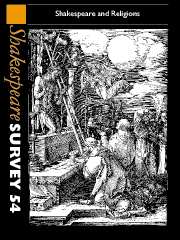Book contents
- Frontmatter
- Shakespeare and the Protestant Mind
- Divine [ ]sences
- ‘An alien people clutching their Gods’?: Shakespeare’s Ancient Religions
- ‘He drew the Liturgy, and framed the rites’: The Changing Role of Religious Disposition in Shakespeare's Reception
- Jonson, Shakespeare, and the Religion of Players
- The Bard and Ireland: Shakespeare’s Protestantism as Politics in Disguise
- ‘Every Good Gift From Above’ Archbishop Trench’s Tercentenary Sermon
- Anthony Munday and The Merchant of Venice
- Perfect Answers: Religious Inquisition, Falstaffian Wit
- When Suicide Becomes an Act of Honour: Julius Caesar and Hamlet in Late Nineteenth-Century Japan
- Religion in Arden
- A Wedding and Four Funerals: Conjunction and Commemoration in Hamlet
- Between Religion and Ideology: Some Russian Hamlets of the Twentieth Century
- Of Shadows and Stones: Revering and Translating ‘the Word’ Shakespeare in Mexico
- Ministers, Magistrates and the Production of ‘Order’ in Measure for Measure
- The Hebrew Who Turned Christian: The First Translator of Shakespeare into the Holy Tongue
- Shakespeare and English Performance Style: The European Context
- All At Sea: Water, Syntax, and Character Dissolution in Shakespeare
- King John, König Johann: War and Peace
- The Tempest’s Forgotten Exile
- The Old Lady, or All is Not True
- Shakespeare Performances in England, 2000
- Professional Shakespeare Productions in the British Isles January-December 1999
- The Year's Contributions to Shakespearian Study 1 Critical Studies
- 2 Shakespeare’s Life, Times, and Stage
- 3 Editions and Textual Studies
- Books Received
- Index
A Wedding and Four Funerals: Conjunction and Commemoration in Hamlet
Published online by Cambridge University Press: 28 March 2007
- Frontmatter
- Shakespeare and the Protestant Mind
- Divine [ ]sences
- ‘An alien people clutching their Gods’?: Shakespeare’s Ancient Religions
- ‘He drew the Liturgy, and framed the rites’: The Changing Role of Religious Disposition in Shakespeare's Reception
- Jonson, Shakespeare, and the Religion of Players
- The Bard and Ireland: Shakespeare’s Protestantism as Politics in Disguise
- ‘Every Good Gift From Above’ Archbishop Trench’s Tercentenary Sermon
- Anthony Munday and The Merchant of Venice
- Perfect Answers: Religious Inquisition, Falstaffian Wit
- When Suicide Becomes an Act of Honour: Julius Caesar and Hamlet in Late Nineteenth-Century Japan
- Religion in Arden
- A Wedding and Four Funerals: Conjunction and Commemoration in Hamlet
- Between Religion and Ideology: Some Russian Hamlets of the Twentieth Century
- Of Shadows and Stones: Revering and Translating ‘the Word’ Shakespeare in Mexico
- Ministers, Magistrates and the Production of ‘Order’ in Measure for Measure
- The Hebrew Who Turned Christian: The First Translator of Shakespeare into the Holy Tongue
- Shakespeare and English Performance Style: The European Context
- All At Sea: Water, Syntax, and Character Dissolution in Shakespeare
- King John, König Johann: War and Peace
- The Tempest’s Forgotten Exile
- The Old Lady, or All is Not True
- Shakespeare Performances in England, 2000
- Professional Shakespeare Productions in the British Isles January-December 1999
- The Year's Contributions to Shakespearian Study 1 Critical Studies
- 2 Shakespeare’s Life, Times, and Stage
- 3 Editions and Textual Studies
- Books Received
- Index
Summary
There are a lot of funerals in Hamlet: four, if you count the first for Hamlet’s father, marred by that one hasty wedding, the ‘hugger-mugger’ (4.5.82) burial of Polonius, Ophelia’s abbreviated obsequies, and finally the somewhat incongruous soldier’s funeral for Hamlet himself. The first three leave the chief mourners bitterly disappointed, and both are almost as distressed by the funeral arrangements as they are by the deaths of their loved ones. Laertes is furious at the ignominious obscurity of his father’s interment, and he is enraged at the priest for denying his sister ‘sage requiem’ (5.1.232). Hamlet is nearly mad with melancholy at the shocking brevity of his mother’s mourning. From beginning to end, this is a play obsessed with getting a decent burial, and nobody seems to get one. What constitutes a decent burial in Shakespeare’s time? The answer is not clear because the Elizabethan religious settlement was so ambiguous on this point. A growing belief in predestination, the subordination of human works to faith alone, and the abolition of purgatory and indulgences made traditional Catholic funeral practices such as the requiem, the annual obit, and other intercessory rites and prayers unnecessary. Elizabeth’s bishops, meeting in convocation in 1563, reaffirmed the Protestant position and denounced ‘sacrifices of Masses . . . for the quick and the dead’ as ‘blasphemous fables, and dangerous deceits’, and the requiem continued to be left out of the vernacular funeral service in The Book of Common Prayer.
- Type
- Chapter
- Information
- Shakespeare Survey , pp. 122 - 139Publisher: Cambridge University PressPrint publication year: 2001
- 1
- Cited by

